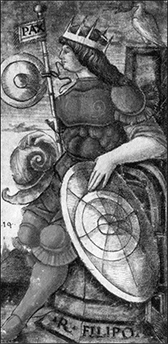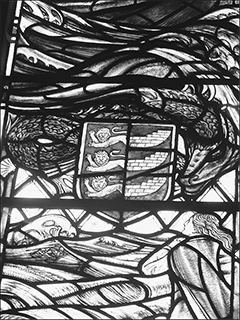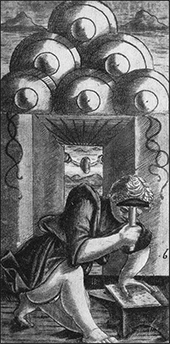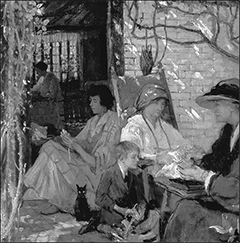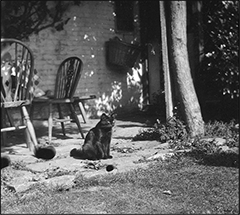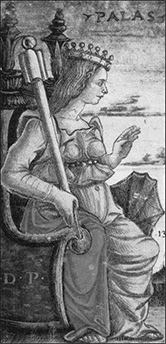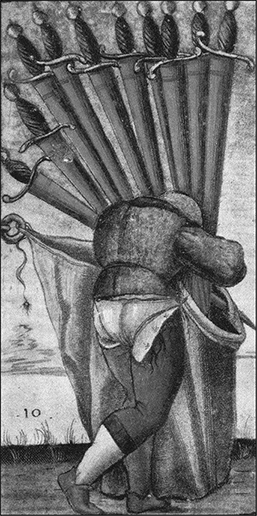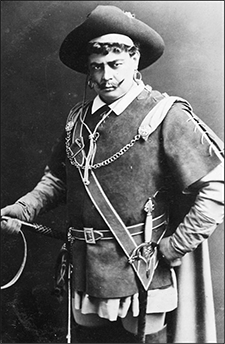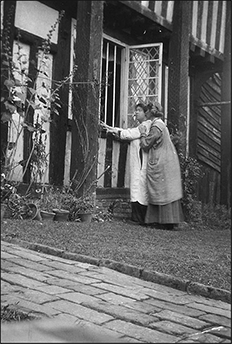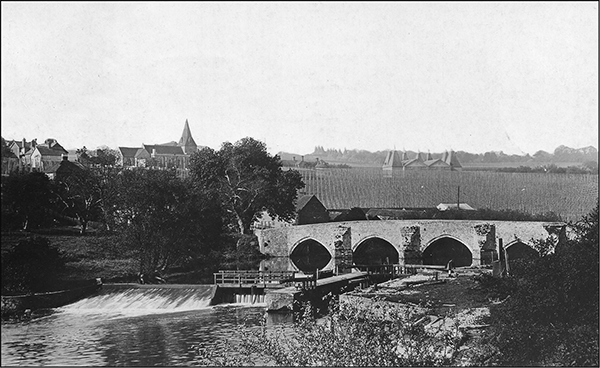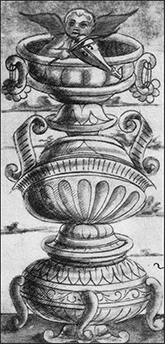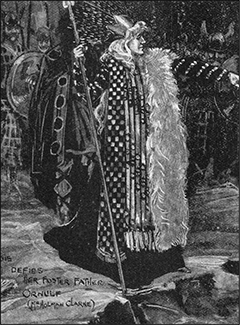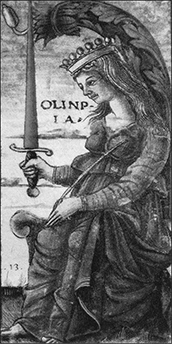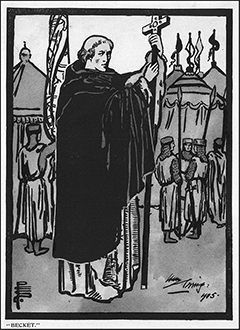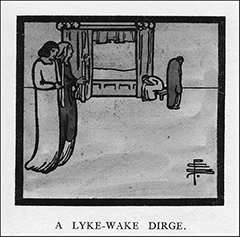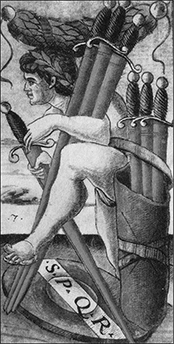The Minors and
Courts Unpacked
Further evidence for Smith’s independence in the creation of the Minor
Arcana can be gleaned from the fact that many of the characters and symbols
that she incorporated in the pips are modelled on her own paintings
that she completed years before receiving the commission.122
Unknown Author
In this chapter we will unpack the meaning and significance of the minor cards using Waite as our primary reference and also referring to Pamela’s card designs. As we know, Waite had little interest in the minor cards, so we have looked more to Pamela’s theatrical background to decipher the symbols she deliberately placed throughout. At the time and in her circle, most of these images would have been immediately recognised, particularly because in several she incorporated actors of the time or her friends.
Our hope is to unlock the many secrets that have long been the source of guesswork and obscure esoteric explanations; you will learn why there is a snail on the 9 of Pentacles; why the figure in the 7 of Wands has mismatched footwear, and the name of the character on the 9 of Pentacles—even the obscure flower that is the source of Pamela’s 2 of Pentacles.
We will also see how Waite’s text and Pamela’s illustrations vary quite dramatically in the minors, and how sometimes a symbol overlapped both worlds, adding rich complexity to the image. Waite said the minors belonged to fortune-telling, and in his “rectified” deck were “furnished with figures or pictures to illustrate—but without exhausting—the divinatory meanings attached thereto.”123 However, there appears to be some requirement to go to a lengthy exposition on the “vague intimations which seem to exceed the stated divinatory values.”124 It seems to us that Waite was covering the fact that his text and Pamela’s designs were at significant variance in some places. He repeated the placing of the minors into the fortune-telling category, and in a rather convoluted manner writes:
It is desirable to avoid misconception by specifying definitely that, except in rare instances—and then only by accident—the variations are not to be regarded as suggestions of higher and extra-divinatory symbolism.125
This appears to be a disclaimer that any esoteric references found in the minors have come from Pamela and are accidental, not designed by him. When we look at several clearly “esoteric” symbols we will indeed find that they are rather more pastiches or cartoons of the specific esoteric symbol they appear to be portraying. This is most evident on the 2 of Cups and the 7 of Cups, where alchemical symbolism is somewhat misrepresented. Contrary to what Waite says, this sort of indirectness can also be found in the majors, where geomantic or astrological symbols are not represented in a structured manner.
Having said that, we see clear indications of some esoterica; the pentacles are clearly arranged in a Tree of Life on the 10 of Pentacles. However, again, there appears to be no holding to strict representation; the Tree is somewhat condensed to make room for the scene, rather than the scene being firmly drawn to the proportions of a Tree of Life. Other symbols will—without a discovery of hidden notes from Pamela—always remain open to interpretation; the two trees on the 9 of Pentacles could be simply stylistic and harmonious elements, or they could be deliberately placed to represent the two trees in the Garden of Eden. The beauty of the deck is that mysteries will beget mysteries.
In revealing the background and most likely explanation for Pamela’s choice of symbolism, it is not intended that we forever enshrine one particular meaning for a card. It is always the case that the symbols are fluid and can be read in any context, changing their meaning in the light of a situation, a question, and the reading’s actual oracular moment. We do hope that learning the story behind the cards will bring you closer to the images and their original design, deepening your readings.
In a later chapter, we will demonstrate a Celtic Cross that uses the newly discovered sources in this book to show how this understanding can enrich a reading.
The order of the minors follows Waite’s version, working “upwards” through the Tree of Life, i.e., starting from the ten of each suit to the Ace. For each court card we provide a brief list of keywords for the card as a person, a part of oneself, or an energy in a situation.126
–The Suit of Pentacles–
King

The figure calls for no special description; the face is rather dark, suggesting also courage, but somewhat lethargic in tendency. The bull’s head should be noted as a recurrent symbol on the throne. The sign of this suit is represented throughout as engraved or blazoned with the pentagram, typifying the correspondence of the four elements in human nature and that by which they may be governed. In many old Tarot packs this suit stood for current coin, money, deniers. I have not invented the substitution of pentacles and I have no special cause to sustain in respect of the alternative. But the consensus of divinatory meanings is on the side of some change, because the cards do not happen to deal especially with questions of money.
Divinatory meanings: Valour, realizing intelligence, business and normal intellectual aptitude, sometimes mathematical gifts and attainments of this kind; success in these paths.
Reversed: Vice, weakness, ugliness, perversity, corruption, peril.
Person: Strong, ambitious, instinctual, and well-grounded.
Part of self: Inner strength
Energy: Bullish
The King is partly inspired by the Sola Busca King of Discs, where we also see the PAX, sign of peace, which Pamela was minded to place on the 6 of Swords.
Queen

The face suggests that of a dark woman, whose qualities might be summed up in the idea of greatness of soul; she has also the serious cast of intelligence; she contemplates her symbol and may see worlds therein.
Divinatory meanings: Opulence, generosity, magnificence, security, liberty.
Reversed: Evil, suspicion, suspense, fear, mistrust.
Person: Deeply intelligent and resourceful.
Part of self: Inner resources.
Energy: Experienced long-term planning.
Pamela would have been familiar with many regal figures through her set design work, theatre experience, and the cabinet cards that were prevalent at the time. This ideally suited her to quickly design the court cards.
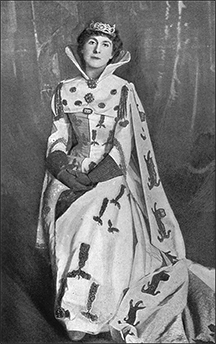
58. The Queen in King Richard II (Mrs. F. R. Benson) from Shakespeare, Complete Works, intro. H. G. Bell (1899). (Courtesy of authors, private collection.)
Knight

He rides a slow, enduring, heavy horse, to which his own aspect corresponds. He exhibits his symbol, but does not look therein.
Divinatory meanings: Utility, serviceableness, interest, responsibility, rectitude—all on the normal and external plane.
Reversed: Inertia, idleness, repose of that kind, stagnation; also placidity, discouragement, carelessness.
Person: Reliable and hardworking individual who is resilient.
Part of Self: Dedication and persistence.
Energy: Enduring.
Page

A youthful figure, looking intently at the pentacle which hovers over his raised hands. He moves slowly, insensible of that which is about him.
Divinatory meanings: Application, study, scholarship, reflection. Another reading says news, messages and the bringer thereof; also rule, management.
Reversed: Prodigality, dissipation, liberality, luxury; unfavourable news.
Person: A young person or somebody who is youthful in outlook and appearance.
Part of self: Simple common sense and studiousness.
Energy: Laidback confidence.
On the tunics: The pages of pentacles and swords wear unadorned tunics, whereas the pages of the cups and wands bear the adornments of their respective elements: lotus flowers for the water of the cups, and salamanders for the fire of the wands. Whether there is any specific reason for this, we do not know.
Ten

A man and woman beneath an archway which gives entrance to a house and domain. They are accompanied by a child, who looks curiously at two dogs accosting an ancient personage seated in the foreground. The child’s hand is on one of them.
Divinatory meanings: Gain, riches; family matters, archives, extraction, the abode of a family.
Reversed: Chance, fatality, loss, robbery, games of hazard; sometimes gift, dowry, pension.
This is the outcome of the planning of the 3 of Pentacles, and the deferred income and hardship of the 5 of Pentacles.
We see here the family together under the arch bearing the flag of Winchelsea. All the risk and hardship has passed.
The secret of this card is the young child who looks out at us with one hand placed on one of the dogs. We think of him as the young Fool who will soon start his journey with his dog on the path of return.
Nine

A woman, with a bird upon her wrist, stands amidst a great abundance of grapevines in the garden of a manorial house. It is a wide domain, suggesting plenty in all things. Possibly it is her own possession and testifies to material well-being.
Divinatory meanings: Prudence, safety, success, accomplishment, certitude, discernment.
Reversed: Roguery, deception, voided project, bad faith.
In the 9 of Pentacles we see most Pamela’s artistry and expression far exceeding Waite’s cursory notion of the card as “a woman, with a bird upon her wrist … .” Whilst he provides meanings such as “prudence, safety, success,” Pamela provides us so much more.
The image is modelled on Rosalind in As You Like It. This role was never played by Ellen Terry (much to her regret in later years) so Pamela might have been most influenced by Ada Rehan, an Irish actress well-known at the time for the role. A cabinet card image of Rehan just thirteen years prior to the deck shows the similarity to Pamela’s depiction, down to the same flowers on the dress.
It is, however, the snail upon the image that provides us the link:
As You Like It
(Act III, scene II)
ROSALIND: Nay, an you be so tardy, come no more in my sight. I had as lief be wooed of a snail.
ORLANDO: Of a snail?
ROSALIND: Ay, of a snail, for though he comes slowly, he carries his house on his head—a better jointure, I think, than you make a woman. Besides, he brings his destiny with him.
ORLANDO: What’s that?
ROSALIND: Why, horns, which such as you are fain to be beholding to your wives for. But he comes armed in his fortune and prevents the slander of his wife.
The snail here on the 9 of Pentacles clearly connects with the concept of self-sufficiency and one who is able to support themselves. It can also be connected with the self-reliant personality, depicted by Rosalind on this card. Here, as in many of the designs, reading further about Shakespeare’s characters—in this case, Rosalind—will deepen your appreciation of the card in everyday reading. Rosalind is a strong and complex woman who has to disguise herself as a man for part of the play to achieve her ambitions.
Eight

An artist in stone at his work, which he exhibits in the form of trophies.
Divinatory meanings: Work, employment, commission, craftsmanship, skill in craft and business, perhaps in the preparatory stage.
Reversed: Voided ambition, vanity, cupidity, exaction, usury. It may also signify the possession of skill, in the sense of the ingenious mind turned to cunning and intrigue.
This card is based on the 6 of Discs from the Sola Busca.
This is the card that demonstrates the importance of steady work and diligence. The young man is the apprentice of the 3 of Pentacles, who has long since gained the professional skill to make something of himself in the world. It is a card of ambition and self-respect, and having a purpose in life. If the 3 of Pentacles is “having perfected the skill,” then the 8 of Pentacles is the status earned and the freedom and security this provides. He is the artisan at work in the world.
If the 8 of Pentacles comes up in the “hopes and fears” position of the Celtic Cross when the querent has asked about the security of a relationship, it implies that whatever they have invested so far will give them the status they deserve.
Seven

A young man, leaning on his staff, looks intently at seven pentacles attached to a clump of greenery on his right; one would say that these were his treasures and that his heart was there.
Divinatory meanings: These are exceedingly contradictory; in the main, it is a card of money, business, barter; but one reading gives altercation, quarrels—and another innocence, ingenuity, purgation.
Reversed: Cause for anxiety regarding money which it may be proposed to lend.
The pentacles (as a suit) have a tendency to speak of responsibility and the need for accountability if one does not take life seriously enough. The 7 of Pentacles is quite a brooding card; it is a card to touch one’s guilty conscience. It urges us to look at what we have created so far and it pushes us to use a little introspection. We ask ourselves had we tried much harder, would we have made a better job of it. It now feels difficult to go back and change things at stage seven of the pentacles journey. It would be easy to throw in the towel at this stage and waste the effort you have put in so far.
Six

A person in the guise of a merchant weighs money in a pair of scales and distributes it to the needy and distressed. It is a testimony to his own success in life, as well as to his goodness of heart.
This design is based on Sir Henry Irving playing Robespierre in the eponymous play—a production in which Pamela was a background extra for the large courtroom scene. Robespierre was a significant figure in the French Revolution who advocated equality between the classes, a trait depicted in this card. He was also known as “the Incorruptible” which gives added significance to Pamela’s design choice for this card, described in Book T as “power, influence, rank, nobility, rule over the people. Fortunate, successful, liberal, and just.” Pamela had also drawn Irving as Robespierre in her illustrations for the 1899 souvenir booklet Sir Henry Irving and Miss Ellen Terry in Robespierre, Merchant of Venice, The Bells, Nance Oldfield, The Amber Heart, Waterloo, etc.
Divinatory meanings: Presents, gifts, gratification; another account says attention, vigilance; now is the accepted time, present prosperity, etc.
Reversed: Desire, cupidity, envy, jealousy, illusion.
This is a card of success, charity, and investment. Things financially have accumulated to the extent that you are able to be more generous with your earnings. It is a good card for investment or charitable considerations. This can be the stage of giving away ten percent of your earnings in tithing. If the 5 of Pentacles was about letting go of being in control of your finances then the 6 of Pentacles turns it all around. It is about you being in control of your finances and giving to others.
Five

Two mendicants in a snowstorm pass a lighted casement.
Divinatory meanings: The card foretells material trouble above all, whether in the form illustrated—that is, destitution—or otherwise. For some cartomancists, it is a card of love and lovers—wife, husband, friend, mistress; also concordance, affinities. These alternatives cannot be harmonized.
Reversed: Disorder, chaos, ruin, discord, profligacy.
This card can mean going without on many levels, exposing yourself to the outside world, no longer being self-sufficient, and having to rely on some other to take care of you. How you express this depends upon what you value most; one person’s idea of going without is very different to another’s. The person in the reading could have given up all their worldly goods, believeing that in living a more spiritual, nonmaterialistic life, they will be looked after by a higher power. This is Waite’s mendicant, the religious asetic. This is the card of letting go of known security and trusting that all will be well. It is all done through pure faith.
In a more mundane way, it could express itself in the form of the gambler who jeopardises his security by banking on his luck improving and the next bet paying off. Or it could be the student who decides to take a year off and risk the unknown in the meantime. It could also be the person who decides to risk all and leave the family and home for a new relationship.
Four

A crowned figure, having a pentacle over his crown, clasps another with hands and arms; two pentacles are under his feet. He holds to that which he has.
Divinatory meanings: The surety of possessions, cleaving to that which one has, gift, legacy, inheritance.
Reversed: Suspense, delay, opposition.
This is the card of relying on material wealth for total security and well-being. This state can create stagnation and an inability to allow changes for fear of loss of control, resulting in inhibited growth. In a reading, this speaks of being stuck and holding to responsibilities of the person’s own making. It can advise the importance of spreading the load. It also suggests the burden that without delegation the security will become a prison.
The 4 of Pentacles is the materialist card of stability and security at any cost. This card can signify a very fixed situation, not one that can be undone easily. It is the card of empire building. In a reading, this card can advise staying put, not moving from where you are now, or standing your ground. Waite’s comment on this card, “cleaving to that which one has” is a way of telling us that the king has spoken, so heed his wise advice.
It could also be applicable to not budging from a decision that you have made or it could actually be a case of not physically moving, say from the home you presently reside in. There is an expression that is used that fits this well: “As safe as houses!” In that if you are going to make any investments, make the investments in something practical, steer away from fantasy and keep it real.
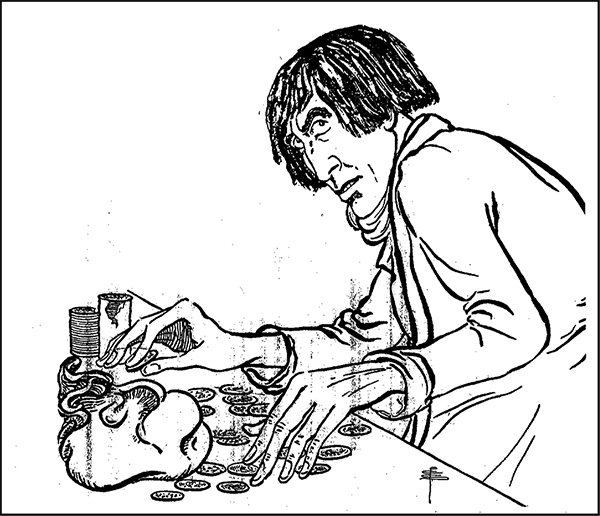
63. Henry Irving in Robespierre, by Pamela Colman Smith. (Courtesy of the National Trust, used under license.)
Three

A sculptor at his work in a monastery. Compare the design which illustrates the Eight of Pentacles. The apprentice or amateur therein has received his reward and is now at work in earnest.
Divinatory meanings: Métier, trade, skilled labour; usually, however, regarded as a card of nobility, aristocracy, renown, glory.
Reversed: Mediocrity, in work and otherwise, puerility, pettiness, weakness.
This is the card of the apprentice who has perfected his skill. He is now proficient enough to be left to his own devices.
Here we have the 3 of Pentacles demonstrating the importance of recognising that the work you put in now will pay off at a later date. This is seen in the 8 of Pentacles where the apprentice has now graduated to artisan and is out in the world being productive. When this card is prominent in a reading, it says, “Discover what you are best at and work to perfect it.” It is the card of career planning. Do not put it off any longer!
Two

A young man in the act of dancing has a pentacle in either hand, and they are joined by that endless cord which is like the number 8 reversed.
Divinatory meanings: On the one hand it is represented as a card of gaiety, recreation, and its connections (the subject of the design) but it is read also as news and messages in writing, as obstacles, agitation, trouble, embroilment.
Reversed: Enforced gaiety, simulated enjoyment, literal sense, handwriting, composition, letters of exchange. In Key, Waite also gives this card as signifying “troubles more imaginary than real,” and a reversed meaning of “bad omen, ignorance, injustice.”
In Key we read further that the design of the card and its interpretation are somewhat different; “on the one hand it is represented as a card of gaiety, recreation … ” whilst it is actually read as “news and messages in writing … ” And the reversed meanings accord with S. L. MacGregor Mathers in his book The Tarot, “handwriting, composition, letters of exchange” as well as “enforced gaiety, simulated enjoyment” (278).
Mathers had already provided meanings for the Deuce of Pentacles: “embarrassment, worry, difficulties.” However it is again in the reversed meaning that we see a specific theme emerging for the card: “letter, missive, epistle, message.” The theme of communication is strong.
Mathers also referred to the detail of the deuce in the European deck he was using: “bound together by a continuous band in such a manner as to form a figure 8,” which “represents the one as being the reflection of the other, as the Universe is that of the Divine Idea” (Tarot, 9).
The surprising answer to this puzzle may come from Edward Burne-Jones, whose work we have seen was influential on Pamela. In the British Museum is bequeathed a wonderful collection of images by Burne-Jones, entitled The Flower Book. It is a series of images inspired by flower names, returning the name to its original mythic source. The image for “False Mercury,” the poisonous flower also known as “Dog’s Mercury,” is one which Pamela may well have seen—the collection was given to the museum in 1909, the year she was creating her tarot.
This is also why we believe it was Pamela who saw the Sola Busca images in the British Museum (although Waite could have done so too) and was inspired when later creating the minors. She may well have had an eye on new stock coming into the museum.
Burne-Jones describes this image as “the Dream-god shewing happy dreams of home to sleeping mariners at sea.”
This is a card of making the most of your situation, assessing the state of your affairs. It is about weighing up your opportunities, seeing what will best work for you. Waite, in describing the action of the young man in the image, he says that he is “in the act of dancing, has a pentacle in either hand, and they are joined by that endless cord which is like the number 8 reversed. On one hand gaiety, recreation and its connexions.” In saying this, he is stressing the importance of taking advantage of networking and sharing of resources, to keep the lively energy flowing. Making contacts and socialising is good and beneficial to be happy and successful in life. However, on the downside, be aware that the more connections you make with others—say through social media, Facebook, and on Twitter—may lead to communications being confused, because as Waite says, “It is read also as news and messages in writing, as obstacles, agitation, trouble, embroilment.” So beware of Facebook trolling and miscommunications! From the reversal view, Waite warns against “forced gaiety, simulated enjoyment,” so keep it real and authentic!
Ace

A hand—issuing, as usual, from a cloud—holds up a pentacle.
Divinatory meanings: Perfect contentment, felicity, ecstasy; also speedy intelligence; gold.
Reversed: The evil side of wealth, bad intelligence; also great riches. In any case it shews prosperity, comfortable material conditions, but whether these are of advantage to the possessor will depend on whether the card is reversed or not.
This is a card of finding yourself in a favourable situation. You will land on your feet with regards to security. It will be presented to you as if it is a gift from above.
–The Suit of Wands–
King

The physical and emotional nature to which this card is attributed is dark, ardent, lithe, animated, impassioned, noble. The King uplifts a flowering wand, and wears, like his three correspondences in the remaining suits, what is called a cap of maintenance beneath his crown. He connects with the symbol of the lion, which is emblazoned on the back of his throne.
Divinatory meanings: Dark man, friendly, countryman, generally married, honest and conscientious. The card always signifies honesty, and may mean news concerning an unexpected heritage to fall in before very long.
Reversed: Good, but severe; austere, yet tolerant.
Person: A dynamic instigator of change.
Part of self: Restless.
Energy: Boundless.
The King is unafraid, as he has self-knowledge of his own limitations and abilities. He can always think one step ahead of anyone else because he is authentic and knows the deeper authenticity of others. When others are fooling themselves, he sees deeper. He’s not the one who opens the door, he is the one who knocks.
Queen

The Wands throughout this suit are always in leaf, as it is a suit of life and animation. Emotionally and otherwise, the Queen’s personality corresponds to that of the King, but is more magnetic.
Divinatory meanings: A dark woman, countrywoman, friendly, chaste, loving, honourable. If the card beside her signifies a man, she is well disposed towards him; if a woman, she is interested in the Querent. Also, love of money, or a certain success in business.
Reversed: Good, economical, obliging, serviceable. Signifies also—but in certain positions and in the neighbourhood of other cards tending in such directions—opposition, jealousy, even deceit and infidelity.
Person: Confident creator of wealth.
Part of self: Passionate.
Energy: Energetic.
As we have seen in the introduction of this book, the Queen of Wands is modelled on Edy Craig and her cat, Snuffles. The chair is found in Smallhythe Place, as are the sunflowers.
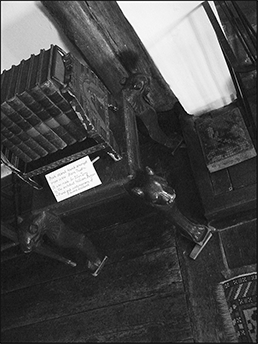
66. Stool at Smallhythe Place, photograph by authors.
There is also an inspiration to this card drawn partly from the Sola Busca version of the Queen of Clubs, depicting Palas.
Knight

He is shown as if upon a journey, armed with a short wand, and although mailed is not on a warlike errand. He is passing mounds or pyramids. The motion of the horse is a key to the character of its rider, and suggests the precipitate mood, or things connected therewith.
Divinatory meanings: Departure, absence, flight, emigration. A dark young man, friendly. Change of residence.
Reversed: Rupture, division, interruption, discord.
Person: Expressive, generous and can be trusted.
Part of self: Conscience.
Energy: Fervent.
The incorporation of costume motifs for the court cards to illustrate their character was both an artistic convention at the time and familiar to those attending theatrical productions.
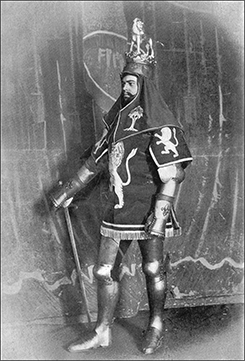
68. Mowbray, Duke of Norfolk, in King Richard II (Mr. Oscar Asche) from Shakespeare, Complete Works, intro. H. G. Bell (1899). (Courtesy of authors, private collection.)
Page

In a scene similar to the former, a young man stands in the act of proclamation. He is unknown but faithful, and his tidings are strange.
Divinatory meanings: Dark young man, faithful, a lover, an envoy, a postman. Beside a man, he will bear favourable testimony concerning him. A dangerous rival, if followed by the Page of Cups. Has the chief qualities of his suit. He may signify family intelligence.
Reversed: Anecdotes, announcements, evil news. Also indecision and the instability which accompanies it.
Person: Bearer of fresh news.
Part of self: Self-aware.
Energy: Enlightening.
Ten

A man oppressed by the weight of the ten staves which he is carrying.
Divinatory meanings: A card of many significances, and some of the readings cannot be harmonized. I set aside that which connects it with honour and good faith. The chief meaning is oppression simply, but it is also fortune, gain, any kind of success, and then it is the oppression of these things. It is also a card of false-seeming, disguise, perfidy. The place which the figure is approaching may suffer from the rods that he carries. Success is stultified if the Nine of Swords follows, and if it is a question of a lawsuit, there will be certain loss.
Reversed: Contrarieties, difficulties, intrigues, and their analogies.
Here we see that Pamela has co-opted the character of the Sola Busca 10 of Swords as more fitting for her 10 of Wands.
The image on this card says it all; the man is overwhelmed by the burden he carries. He does not stop and let go, because the work is nearly over and there is no going back. He is at the “Ten stage” in his journey, and he will benefit from the effort he has put in so far. The card can warn against treachery—take care whom you trust, as they may not be genuine.
Nine

The figure leans upon his staff and has an expectant look, as if awaiting an enemy. Behind are eight other staves—erect, in orderly disposition, like a palisade.
Divinatory meanings: The card signifies strength in opposition. If attacked, the person will meet an onslaught boldly; and his build shews that he may prove a formidable antagonist. With this main significance there are all its possible adjuncts—delay, suspension, adjournment.
Reversed: Obstacles, adversity, calamity.
In a reading this, speaks of being ready for any eventuality; this is a card that recommends having your defences up. It is the preparation that will make the difference in a successful outcome. If this card comes up in response to a question regarding a legal matter, it can recommend going ahead as it will be favourable, especially if you are well prepared.
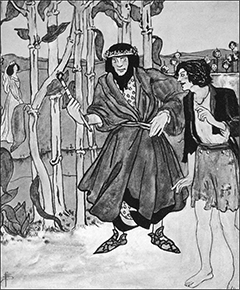
70. Jack and the King from In Chimney Corners (1899), illustrated by Pamela Colman Smith. (Illustration courtesy of authors, private collection.)
Eight

The card represents motion through the immovable—a flight of wands through an open country; but they draw to the term of their course. That which they signify is at hand; it may be even on the threshold.
Divinatory meanings: Activity in undertakings, the path of such activity, swiftness, as that of an express messenger; great haste, great hope, speed towards an end which promises assured felicity; generally, that which is on the move; also the arrows of love.
Reversed: Arrows of jealousy, internal dispute, stingings of conscience, quarrels; and domestic disputes for persons who are married.
Something has already been put in motion. At this stage in the game, there is no turning back; you must accept what has gone and bless it on its way or hope for the best possible outcome. If this card is in the Celtic Cross’s “future” position, it suggests a yet-to-transpire unavoidable occurrence that is the result of a past action. However, it is positive, for as Waite says, it “promises assured felicity.” Be assured that all’s well that will end well.
Seven

A young man on a craggy eminence brandishing a staff; six other staves are raised towards him from below.
Divinatory meanings: It is a card of valour, for, on the surface, six are attacking one, who has, however, the vantage position. On the intellectual plane, it signifies discussion, wordy strife; in business—negotiations, war of trade, barter, competition. It is further a card of success, for the combatant is on the top and his enemies may be unable to reach him.
Reversed: Perplexity, embarrassments, anxiety. It is also a caution against indecision.
The Secret of the Mismatched Shoes
One feature of this image is that the figure wears obviously mismatched footwear. It has been commented on with various explanations, although the obvious answer is (as ever) in Pamela’s theatrical background. The image would have been instantly recognisable to her and her friends—although it may well have passed Waite by, given his lack of involvement and interest in the minors. It would be similarly the case with the 9 of Cups, 9 of Pentacles, and other cards. The character in this card is Petruchio, from Shakespeare’s play, The Taming of the Shrew. He is the character who is trying to “tame” his wife-to-be, so he arrives very badly dressed for their wedding:
Why, Petruchio is coming in a new hat and an old jerkin, a pair of old breeches thrice turned, a pair of boots that have been candle cases, one buckled, another laced; an old rusty sword ta’en out of the town armory, with a broken hilt and chapeless; with two broken points … [Act III, scene II]
We see immediately that Pamela has deliberately drawn one buckled boot and one laced shoe—and the loose lace is even completely clear. On our website supporting this book, you can see another photograph of Petruchio (played by Oscar Ashe) wearing one boot and one shoe as Pamela had drawn him.That the character is fighting off the odds is simply a scene that follows in the wedding, where Petruchio exclaims:
They shall go forward, Kate, at thy command.
Obey the bride, you that attend on her;
Go to the feast, revel and domineer,
Carouse full measure to her maidenhead;
Be mad and merry, or go hang yourselves.
But for my bonny Kate, she must with me.
Nay, look not big, nor stamp, nor stare, nor fret;
I will be master of what is mine own—
She is my goods, my chattels, she is my house,
My household stuff, my field, my barn,
My horse, my ox, my ass, my any thing,
And here she stands; touch her whoever dare;
I’ll bring mine action on the proudest he
That stops my way in Padua. Grumio,
Draw forth thy weapon; we are beset with thieves;
Rescue thy mistress, if thou be a man.
Fear not, sweet wench; they shall not touch thee, Kate;
I’ll buckler thee against a million.
—[Act III, scene II]
Yet again, we see Pamela’s design providing a richness of interpretation far beyond Waite’s words. The card here carries the ideas of a war of words, battling down someone’s position by belittling and even bullying them. All the complex ideas, scenarios, and character interactions of a full play by Shakespeare are carried by this one image.127
Six

A laurelled horseman bears one staff adorned with a laurel crown; footmen with staves are at his side.
Divinatory meanings: The card has been so designed that it can cover several significations; on the surface, it is a victor triumphing, but it is also great news, such as might be carried in state by the King’s courier; it is expectation crowned with its own desire, the crown of hope, and so forth.
Reversed: Apprehension, fear, as of a victorious enemy at the gate; treachery, disloyalty, as of gates being opened to the enemy; also indefinite delay.
In a reading, this could suggest a successful situation, but be ready for the unexpected.
This is the card of victory—success is assured. If we consider the 8 of Wands as the objectives that were put in motion, then the 6 of Wands is the successful outcome. The energy that was put in has paid off.
The use of the “silent knight” image from 1903 shows that Pamela saw this card, based on the Golden Dawn title of “Victory,” as one of a quiet victory, perhaps a noble triumph. As Waite commented on the idea of it being a “king’s courier,” we also get the practical meaning of this card as someone who is transmitting a secret between two parties. This bears the reversed connotation of an enemy at the gates, as Waite remarks. If you share a friend request on a social media site, it may be that your secrets are also at risk when this card is present in your readings.
Many of Shakespeare’s history plays begin with the victor, the hero returning home to reap the benefits he has earned in war. In Pamela’s depiction of the 6 of Wands, she has created one of these images. The horse is very significant in this, in that it is known that the crafty little look on its face puts a smile on our face because we know that it is going do something unexpected at any moment. With her experience of the stage and acting world, Pamela would have been aware of the saying in the acting fraternity: “Never work with animals or children.” We see this very same scene, even down to the distracted horse, in a little sketch that Pamela made on a letter to her cousin, Mary B. Reed, while in Jamaica. The image came from the play Herne the Hunter, and in this same letter she spoke of the play, and particularly the procession at the start. The sketch also has one of the characters holding a sign up that spells out “REX,” Latin for “king.” Therefore, we suggest that the image of the 6 of Wands could be replaced by Pamela’s original sketch of Herne the Hunter on his steed accompanied by other wild huntsmen and even the souls of unfortunates who have met him on his hunts.
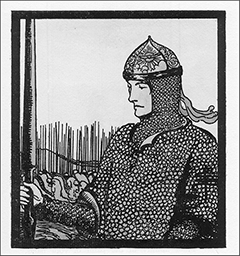
72. The Silent Knight by Pamela Colman Smith, 1903. (Illustration courtesy of Koretaka Eguchi, private collection.)
Five

A posse of youths, who are brandishing staves, as if in sport or strife. It is mimic warfare, and hereto correspond the Divinatory Meanings.
Divinatory meanings: Imitation, as, for example, sham fight, but also the strenuous competition and struggle of the search after riches and fortune. In this sense it connects with the battle of life. Hence some attributions say that it is a card of gold, gain, opulence.
Reversed: Litigation, disputes, trickery, contradiction.
This is Pamela and the gang erecting trellises at Smallhythe. We have a photograph of the gang doing this, and the end result. The card can also be seen as work in progress, or it may also signify finding as much joy in the task as the end result; this is true camaraderie at play.
This is a card of going through the motions of activity but not actually getting anything done. The characters on the card are young and full of show, but all is not as it seems. Waite says it is “mimic warfare” and “imitation.” In a reading, it would say to not be impressed by what appears to be happening; it could merely be for show.
Four

From the four great staves planted in the foreground there is a great garland suspended; two female figures uplift nosegays; at their side is a bridge over a moat, leading to an old manorial house.
Divinatory Meanings: They are for once almost on the surface—country life, haven of refuge, a species of domestic harvest-home, repose, concord, harmony, prosperity, peace, and the perfected work of these.
Reversed: The meaning remains unaltered; it is prosperity, increase, felicity, beauty, embellishment.
This card is an idealised depiction of life at Smallhythe and Winchelsea; the Margate Bridge is in the background as we see in the 5 of Cups. This is the approach to the sisterhood as the 5 of Cups represents the departure. It signifies sisterhood, a home away from home, a sanctuary of like minds, and celebration of all good things. This shows the successful results of a job well done.
This is a card that speaks of coming home to where you belong. The importance of taking time out away from the stresses and strains of your workaday life. The work has been done for now; it is time to rest as Waite says “harvest home.” Let the festivities commence!

73. Ellen Terry’s Cottage, c. 1909.(Courtesy of the Victoria and Albert Museum, London, used under license.)
Three

A calm, stately personage, with his back turned, looking from a cliff’s edge at ships passing over the sea. Three staves are planted in the ground, and he leans slightly on one of them.
Divinatory meanings: He symbolizes established strength, enterprise, effort, trade, commerce, discovery; those are his ships, bearing his merchandise, which are sailing over the sea. The card also signifies able co-operation in business, as if the successful merchant prince were looking from his side towards yours with a view to help you.
Reversed: The end of troubles, suspension or cessation of adversity, toil and disappointment.
In this scene, we see the shipbuilder of the five ports (Winchelsea and the surrounding area) seeing off his creations. His work is done, but the journey has only just begun. He is a cog in commerce. The livelihood of many depends on the safe passage of these ships. In a reading, this means industriousness creating security for the future. However, it is still early days and care has to be taken to ensure nothing goes wrong. Kings commissioned the shipbuilders of Winchelsea to build ships; a lot of pressure would be on them to satisfy the exacting demands put upon them. In a real-life reading, this could represent being under pressure to perform well and come up with a good result at the end, lest you incur a superior’s wrath.
The image design bears a similarity to the scene in Pamela’s illustration for The Merchant of Venice, where the quote “Hath a dog money?” gives a spin on Waite’s view that this is a card of “business co-operation.” The scene Pamela is drawing upon is where Antonio goes to Shylock for money, having already insulted him. It perhaps tells us that Pamela saw in this card a case for looking properly after one’s business relationships as well as the money.
This is the card of enterprise and success that comes from making the most of opportunities. It can speak of working together for the good of many, rather than for just the one—my success is yours and vice versa. In a reading, it could signify help coming your way in the form of investment.

74. The Merchant of Venice, illustrated by Pamela Colman Smith. (Illustration courtesy of authors, private collection.)
Two

A tall man looks from a battlemented roof over sea and shore; he holds a globe in his right hand, while a staff in his left rests on the battlement; another is fixed in a ring. Note the rose and lily cross on the left side.
Divinatory meanings: Between the alternative readings there is no marriage possible; on the one hand, riches, fortune, magnificence; on the other, physical suffering, disease, chagrin, sadness, mortification. The design gives one suggestion; here is a lord overlooking his dominion and alternately contemplating a globe; it looks like the malady, the mortification, the sadness of Alexander amidst the grandeur of this world’s wealth.
Reversed: Surprise, wonder, enchantment, emotion, trouble, fear.
This scene is reminiscent of the painting Comes He Not by the pre-Raphaelite painter Edward Burne-Jones, as we have seen earlier in the The Flower Book. The work of Burne-Jones greatly influenced Pamela, so if we apply what we can see in this painting, the result is a picture of expectation, waiting for the return of a loved one. In Pamela’s depiction of the 2 of Wands, the waiting figure is male and in his palm he hold the world, as if to say“For your safe return I would give the whole world, for without you I am nothing.” In a reading, this card could suggest putting your personal affairs into perspective, thinking about what is really important in life. At the end of our lives, it is very unlikely that we’ll regret not making more money; more likely we will regret a lost love or opportunity not taken.
This card speaks of the danger of materialism; the accomplishments of ambition and the gaining of status does not always bring contentment. Waite speaks of this when he compares the figure on the battlement to Alexander the Great. He says, “It looks like the malady, the mortification, the sadness of Alexander amidst the grandeur of this world’s wealth” (PKT, 194). The character depicted on the 2 of Wands is confusing worth with wealth; in his ambition, he mistakenly believes that his value in the world will be measured purely by his physical rewards.
Ace

A hand issuing from a cloud grasps a stout wand or club.
Divinatory meanings: Creation, invention, enterprise, the powers which result in these; principle, beginning, source; birth, family, origin, and in a sense the virility which is behind them; the starting point of enterprises; according to another account, money, fortune, inheritance.
Reversed: Fall, decadence, ruin, perdition, to perish; also a certain clouded joy.
Through Pamela this would be her hand, the creative hand grasping and bringing to life her creation, her art, the creation of a tarot deck that would go on and on. It is the legacy she would leave behind. If this card comes up in a reading, it is urging the need to stir up your energy and create something that will stand the test of time. The keyword here is “create.” In a relationship query (perhaps a question of commitment), this card in a future position would be very favourable, as something good and long-lasting is going to come out of the relationship.
–The Suit of Cups–
If we look closely at the cups Pamela painted, we see they are a very specific design, almost dumbbell in shape, with large stems. They are not ornate but appear less functional as cups and closer to the ritual version she would have experienced in the Golden Dawn. However, there is a closer model in her Catholic experience: the ciborium, the large covered cup that stores the host during the Eucharist. We see a more ornate version of a ciborium on the Queen of Cups, and this explains why Waite says of her that her activity “feeds her dream”; the vision is the host realised by her activity.
Furthermore, whilst Pamela has drawn on the Catholic image, Waite has superimposed on this via his text a more Holy Grail-based notion, particularly the cup as the source of vision. We see this mentioned several times in his text, resulting in the cups carrying both layers of symbolism. On the Grail, Waite writes that it is “in the root a reliquary legend. This legend was taken over and connected with rumours of a secret doctrine concerning the Eucharist and the priesthood, being part of a tradition handed down within the Church, but unconsciously to the Church at large.”128 To Waite, the cup is the symbol of the Beatific Vision, the immediate knowledge of God. He states that the “rose is also a chalice, and its mystery is that of the chalice of salvation.”129 It is to this aim he dedicated his life and the inner working of his secret order, the F. R. C.
King

He holds a short sceptre in his left hand and a great cup in his right; his throne is set upon the sea; on one side a ship is riding and on the other a dolphin is leaping. Implicit is the Sign of the Cup naturally referring to water, which appears in all the court cards.
Divinatory meanings: Fair man, man of business, law, or divinity; responsible, disposed to oblige the Querent; also equity, art and science, including those who profess science, law and art; creative intelligence.
Reversed: Dishonest, double-dealing man; roguery, exaction, injustice, vice, scandal, pillage, considerable loss.
Person: An advocate, champion of wronged.
Part of self: One’s integrity.
Energy: Fairness.
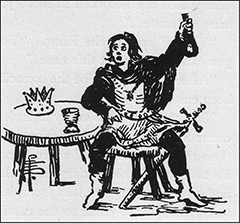
75. An Alternate King of Cups from A Book of Friendly Giants, illustrated by Pamela Colman Smith, 1914. (Illustration courtesy of authors, private collection.)
Queen

Beautiful, fair, dreamy—as one who sees visions in a cup. This is, however, only one of her aspects; she sees, but she also acts, and her activity feeds her dream.
Divinatory meanings: Good, fair woman; honest, devoted woman, who will do service to the Querent; loving intelligence, and hence the gift of vision; success, happiness, pleasure; also wisdom, virtue; a perfect spouse and a good mother.
Reversed: The accounts vary; good woman; otherwise, distinguished woman but one not to be trusted; perverse woman; vice, dishonour, depravity.
Person: A visionary.
Part of self: Intuitive.
Energy: Healing and reassuring.
This card is one of several that draw upon images from the Sola Busca deck. The serpent rising out of the original Sola Busca and the four sea animals rising out of the Golden Dawn versions of the Cup court cards have been simplified by Pamela into the single fish in the Page of Cups.
The character named on the Sola Busca card is that of Polisena (Polyxena), the Greek mythical daughter of King Priam and Queen Hecuba. Whilst the stories vary, in several she is ambushed whilst retrieving water (with an amphora, depicted on the card) and sacrificed. The snake issuing from the vessel may here indicate treachery and betrayal.
Knight

Graceful, but not warlike; riding quietly, wearing a winged helmet, referring to those higher graces of the imagination which sometimes characterize this card. He too is a dreamer, but the images of the side of sense haunt him in his vision.
Divinatory meanings: Arrival, approach—sometimes that of a messenger; advances, proposition, demeanour, invitation, incitement.
Reversed: Trickery, artifice, subtlety, swindling, duplicity, fraud.
Person: A mediator or peacemaker.
Part of self: Peace loving.
Energy: Calming.
Page

A fair, pleasing, somewhat effeminate page, of studious and intent aspect, contemplates a fish rising from a cup to look at him. It is the pictures of the mind taking form.
Divinatory meanings: Fair young man, one impelled to render service and with whom the Querent will be connected; a studious youth; news, message; application, reflection, meditation; also these things directed to business.
Reversed: Taste, inclination, attachment, seduction, deception, artifice.
Person: A dreamer.
Part of self: Inner child.
Energy: Meditative.
The choice of a fish rising from a cup is a specific symbol and presently unidentified as to its source. We believe though that the term “drunk as a fish” may have some bearing on our Page of Cups. It is used in Shakespeare’s Henry IV (see also 9 of Cups) when Falstaff refers to being a “soused Gurnet” (Henry IV, Part I, Act IV, Sc. II). The word “souse” is the term for both dousing something in a liquid and preparing a dish, and the word “gurnet” is a type of fish. Indeed, this is the same play in which Falstaff refers to the Prince as “a Jack, a sneak-cup” (Act III, Sc. III). This old phrase is lost now, but likely means someone who is not to be trusted, is not true to their emotions.
At a deeper level, the fish is symbolic of Christ, specifically denoting the miracle of the fishes and loaves. This miracle was also related in the Grail mysteries where the knight Brons brings to the table a fish that feeds many. A Greek story tells of a golden cup hidden inside a fish, which a fisherman discovers and finds the cup produces gold coins.
Orpheus is also known as a “fisher” and his lyre was said to be able to charm creatures to him. Consider also the salmon of wisdom in Celtic lore, which ate the hazelnuts that fell from magical hazel trees surrounding a deep pool. When the fish ate one nut from all nine trees, it gained all the world’s knowledge.
In psychological terms, the fish is the emblem of the deep unconscious.130
Ten

Appearance of Cups in a rainbow; it is contemplated in wonder and ecstasy by a man and woman below, evidently husband and wife. His right arm is about her; his left is raised upward; she raises her right arm. The two children dancing near them have not observed the prodigy but are happy after their own manner. There is a home-scene beyond.
Divinatory meanings: Contentment, repose of the entire heart; the perfection of that state; also perfection of human love and friendship; if with several picture-cards, a person who is taking charge of the Querent’s interests; also the town, village or country inhabited by the Querent.
Reversed: Repose of the false heart, indignation, violence.
The 10 of Cups signifies an abundance of happiness. It is a place of acceptance and unconditional love, where all will be well. This is the card of family union and communing with those we care for most.
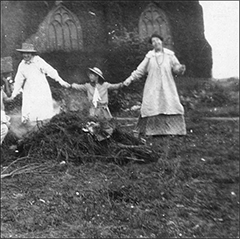
77. Pamela Colman Smith at Smallhythe Place, c. 1909. (Courtesy of the National Trust, used under license.)
Nine

A goodly personage has feasted to his heart’s content, and abundant refreshment of wine is on the arched counter behind him, seeming to indicate that the future is also assured. The picture offers the material side only, but there are other aspects.
Divinatory meanings: Concord, contentment, physical bien-etre; also victory, success, advantage; satisfaction for the Querent or person for whom the consultation is made.
Reversed: Truth, loyalty, liberty; but the readings vary and include mistakes, imperfections, etc.
Here we see Pamela has taken inspiration from Shakespeare’s Sir John Falstaff from Henry IV parts I and II. This comical character is very pleased with himself, indeed. The character in the play had once been a page to the Duke of Norfolk, so it is interesting to see his development from a page who holds just one cup to the man of nine Cups!
Henry IV, Part I
Act I, scene II
FALSTAFF
Thou art so fat-witted, with drinking of old sack
and unbuttoning thee after supper and sleeping upon
benches after noon, that thou hast forgotten to
demand that truly which thou wouldst truly know.
What a devil hast thou to do with the time of the
day? Unless hours were cups of sack and minutes
capons and clocks the tongues of bawds and dials the
signs of leaping-houses and the blessed sun himself
a fair hot wench in flame-coloured taffeta, I see no
reason why thou shouldst be so superfluous to demand
the time of the day.
Pamela has clearly depicted the lord of material happiness as Falstaff, with the cups of ale (sack), the unbuttoned shirt (at top), and most specifically—in accordance with the script—a bench, rather than any other type of seat or chair. The hat type is also reminiscent of typical dress for the character as seen in the preceding photograph.
In fact, this card alone tells us that Pamela likely had a fuller copy of Book T from the Golden Dawn in that their description of this card could not have been more properly revisioned as the character of Falstaff by Pamela.
Book T’s description is thus: “Complete and perfect realization of pleasure and happiness, almost perfect; self-praise, vanity, conceit, much talking of self yet kind and lovable, and may be self-denying therewith. High-minded, not easily satisfied with small and limited ideas. Apt to be maligned through too much self-assumption. A good and generous, but sometimes foolish nature.”
The comparison to the character of Falstaff is unmistakable.
Eight

A man of dejected aspect is deserting the cups of his felicity, enterprise, undertaking or previous concern.
Divinatory meanings: The card speaks for itself on the surface, but other readings are entirely antithetical—giving joy, mildness, timidity, honour, modesty. In practice, it is usually found that the card shews the decline of a matter, or that a matter which has been thought to be important is really of slight consequence—either for good or evil.
Reversed: Great joy, happiness, feasting.
Whilst this evocative image of a man walking away from his cups may seem dream-like, even nightmarish, it is rooted in reality. Pamela not only painted here the Romney Marshes of the landscape near Winchelsea, but also the lunar eclipse that she likely witnessed at the time of the deck’s creation. This landscape, a wetland area that stretches a fair distance, is haunted by tales of lost towns and smuggling, and was used as a setting by several authors such as E. F. Benson, Russell Thorndike, and Monica Edwards. It brings to the card the sense of lost opportunities, forgotten deeds, and wasted commitments. Over the scene hangs a moon eclipsed by the shadow of the passing sun, so even it shines not fully upon where we walk away from our own past.
The Eclipse
The eclipse featured in this card (and arguably the 2 of Swords, also a tidal/coastal card) and the moon itself is drawn from Pamela’s real life. In June 1909, as she began the deck, there was a lunar eclipse visible in England on June 3 and 4. However, according to astronomical society reports on that night, there were persistent cloudy conditions in London. Luckily, in other places such as Leeds the sky was clear, and coincidentally the best weather of that month is recorded as being in one particular place—Tenterden, the exact area in which Pamela was staying at the time.
It is more than likely Pamela saw the full lunar eclipse and worked it into her deck. The eclipse was described as having a “seamy aura” which made the shadow line on the moon rather “sinuous.” There were also reports of a “curious glow” in the northern horizon, as if of an auroral display.
Seven

Strange chalices of vision, but the images are more especially those of the fantastic spirit.
Divinatory meanings: Fairy favours, images of reflection, sentiment, imagination, things seen in the glass of contemplation; some attainment in these degrees, but nothing permanent or substantial is suggested.
Reversed: Desire, will, determination, project.
The brief description Waite gives here contains an alchemical secret to this card, one that Waite may have requested of Pamela, although her specific knowledge of alchemy resulted in a rather cursory sketch of symbols. The strange symbols in these seven chalices are stages of the alchemical process, based on Michael Maier. The clue is the phrase “of the fantastic spirit,” which Waite had used the year prior in his article, “Pictorial Symbols of Alchemy.” He wrote of Maier:
He was a man of great and exceptional learning, but withal of a fantastic spirit; he is proportionately difficult to judge, but his primary concern was the material side of the Magnum opus.131
Looking at several of the symbols in the chalices such as the “hidden” skull on the cup containing the wreath, we see alchemical symbols, specifically the snake and the salamander. These are also general symbols outside of alchemy, of course, but together here they form a specific sequence. The transformative stages of alchemy are categorised differently according to various authors, but often fall into a pattern as thus:
- Calcination
- Dissolution
- Separation
- Conjunction
- Fermentation
- Distillation
- Coagulation132
Whilst we cannot be perfectly sure about corresponding these stages to Pamela’s symbols, as we know the first stage is the fire of calcination, this would match the salamander. The second stage, dissolution, could be pictured as the victory in death of the cup next to it. Separation sorts the valuable materials of the first matter into the treasure of the third cup. The whole process is consolidated in the fourth cup, of conjunction, constructing a new “building” of the soul. If we continue reading the upper row from right to left, the next stage of fermentation is ably symbolised by the snake, and the purity of distillation by the divine figure. The final stage, coagulation, is the complete philosopher’s stone, the perfected human being.
We could make a case that the central cup represents the final stage, and the other six cups are the prior order of transformations, although without clear symbolism, we’d be guessing. What is of use is that these seven cups can be used within a reading as indicating the seven stages of transformation we must undergo in any creative or spiritual process.
Six

Children in an old garden, their cups filled with flowers.
Divinatory meanings: A card of the past and of memories, looking back, as—for example—on childhood; happiness, enjoyment, but coming rather from the past; things that have vanished. Another reading reverses this, giving new relations, new knowledge, new environment, and then the children are disporting in an unfamiliar precinct.
Reversed: The future, renewal, that which will come to pass presently.
These childlike figures are reminiscent of the characters of Mytyl and her brother Tyltyl in The Blue Bird (1908) by the Symbolist playwright and mystic Maurice Maeterlinck (1862–1949). We know that Maeterlinck worked very closely with Edward Gordon Craig and we know Pamela had worked with Edward Gordon Craig on his “toy theatre” creation. Maeterlinck himself was interested in writing a Shakespearian play for marionettes and it turns out that Pamela was complimented at one time for being the most appropriate artist to “translate” Maeterlinck’s work to art.133
This also brings to mind Pamela’s passion for toy theatre and storytelling. As you can see in this card, Pamela’s figures are sometimes difficult to distinguish—are these children or brownies?—owing to their different proportions in comparison to their environment
The scene carries strong echoes of Pamela’s own view and life whilst staying at Smallhythe. We like to think that she stood outside to sketch whilst listening to music from the gramphone through an open window. When we stand at Smallhythe Place, we can almost imagine the scene. The odd thing is that when we took the photograph of the courtyard that reminded us of the 6 of Cups, we failed to notice the two figures in the far left of the background.
There is significant evidence that the mismatched figures on the 6 of Cup, the flowers, the glove, guardsman, and other elements of this scene are drawn from Nance Oldfield, a play that starred Ellen Terry and was quite popular as a “blend of humor and gooey pathos” (according to one review). In fact, the play was so popular that it allowed Terry to purchase Tower Cottage. Nance Oldfield is based on the real-life actress Anne Oldfield and features a young poet who falls for an actress. As she is older than he, she resists his advances in a series of comical exchanges, playing down herself.
The play fits the theme perfect as given in Book T: “contention and strife arising from unwarranted self-assertion and vanity.” The young poet thinks the woman is younger—and she rebuffs his unwarranted self-assertion.
Pamela painted a portrait of Ellen as Nance Oldfield that shows the same curly hair, headscarf, and flower pots in the card, as they were well-known motifs for the character. There are perhaps further clues that in addition to being an actress, the real Anne Oldfield was a florist, sometimes seamstress, and most significantly, the daughter of a captain of the watch (the figure in the card’s background). Another side-sketch Pamela did of Ellen as Nance Oldfield appears in the 1899 souvenir booklet Sir Henry Irving and Miss Ellen Terry shows the similarity even more markedly.
The real Anne Oldfield was famously buried wearing white kidskin gloves, and a surviving portrait of her that may have been familiar to Pamela shows her right hand wrapped in a shawl, matching what is painted on the card. More discussions and illustrations can be found at www.waitesmithtarot.com.
Five

A dark, cloaked figure, looking sideways at three prone cups; two others stand upright behind him; a bridge is in the background, leading to a small keep or holding.
Divinatory meanings: It is a card of loss, but something remains over; three have been taken, but two are left; it is a card of inheritance, patrimony, transmission, but not corresponding to expectations; with some interpreters it is a card of marriage, but not without bitterness or frustration.
Reversed: News, alliances, affinity, consanguinity, ancestry, return, false projects.
The image of the sombre cloaked figure conjures up the sadness of leaving a place where you have been most happy. We make a story that this is the melancholy Pamela experienced as she departed from Smallhythe. She would have passed over a well-known bridge on every visit, at Maidstone. We compare this card to the 4 of Wands where we see the same bridge, in that case the pleasure of arriving, not the sadness of departing.
Four

A young man is seated under a tree and contemplates three cups set on the grass before him; an arm issuing from a cloud offers him another cup. His expression notwithstanding is one of discontent with his environment.
Divinatory meanings: Weariness, disgust, aversion, imaginary vexations, as if the wine of this world had caused satiety only; another wine, as if a fairy gift, is now offered the wastrel, but he sees no consolation therein. This is also a card of blended pleasure.
Reversed: Novelty, presage, new instruction, new relations.
This is a card of loss and hope. There are times when we feel that we have failed at something and despair at the waste. This card reassures us that all is not lost and that no matter how bad we feel at the moment, something good will still come out of a bad situation. It may require moving on and looking on life with a new perspective.
Three

Maidens in a garden-ground with cups uplifted, as if pledging one another.
Divinatory meanings: The conclusion of any matter in plenty, perfection and merriment; happy issue, victory, fulfilment, solace, healing.
Reversed: Expedition, dispatch, achievement, end. It signifies also the side of excess in physical enjoyment, and the pleasures of the senses.
This card speaks of the importance of being true to yourself and only spending time with those who count. We become that with which we surround ourselves! The image conjures the “suffragette pledge,” and we know Pamela was involved with the movement; she, Edy Craig, and the writer Christopher St. John all contributed time and creative abilities to the cause. The sisterhood of Smallhythe was where Pamela would convene with loved ones who shared the same ideals and values. It was a woman’s sanctuary where they could relax and be themselves without censure from the outside world. 1910 was a breakthrough time for suffragettes; the Conciliation Bill came to Parliament, which would give the right to vote to a million women like Ellen Terry, who owned their own land and property.
Two

A youth and maiden are pledging one another, and above their cups rises the Caduceus of Hermes, between the great wings of which there appears a lion’s head. It is a variant of a sign that is found in a few old examples of this card. Some curious emblematical meanings are attached to it, but they do not concern us in this place.
Divinatory meanings: Love, passion, friendship, affinity, union, concord, sympathy, the interrelation of the sexes, and—as a suggestion apart from all offices of divination—that desire which is not in Nature, but by which Nature is sanctified.
Note: The 2 of Cups is the only minor card that does not have a reversed meaning given in Pictorial Key, in the earlier Key to the Tarot, or the shortened version of that book appended to Pictorial Key. Whether this was a continuous oversight or deliberate omission we have no idea.
This image is from Romeo and Juliet. Mercutio says in Act I, scene IV: “You are a lover; borrow Cupid’s wings, and soar with them above a common bound.” It is interesting that the wand between the lovers here is that of Mercury. Another reference to Romeo and Juliet appears later in that the cup will soon bear the sleeping draught to Juliet’s lips, the results of this completed in the 9 of Swords.
This card is based partially on the Two of Amphorae in the Sola Busca.
We also wonder what Pamela would have done if she had been given more time with any of these images. If we compare the following painting from Chimney to her 2 of Cups, we see how much detail she may have been able to conjure given more time.
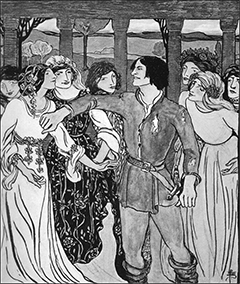
83. Then Jack went into the Castle from A Book of Friendly Giants, illustrated by Pamela Colman Smith, 1914. (Illustration courtesy of authors, private collection.)
Ace

The waters are beneath, and thereon are water-lilies; the hand issues from the cloud, holding in its palm the cup, from which four streams are pouring; a dove, bearing in its bill a cross-marked Host, descends to place the Wafer in the Cup; the dew of water is falling on all sides. It is an intimation of that which may lie behind the Lesser Arcana.
Divinatory meanings: House of the true heart, joy, content, abode, nourishment, abundance, fertility; Holy Table, felicity hereof.
Reversed: House of the false heart, mutation, instability, revolution.
The symbol of the Ace of Cups was an opportunity for Pamela to present her (and Waite’s) Catholic theme within their tarot. In it is clearly depicted the chalice used in the Mass, with the dove descending to lower the wafer into the chalice’s blood.
On the cup amidst several small bells (in an unusual and unique design not elsewhere shown on the cups) is the reversed letter M. When placed with the Cross upon the wafer, this creates the symbol of the Médaille miraculeuse, the miraculous medal of the Immaculate Conception. This symbol was received in a vision by Catherine Labouré in 1830 and is popular whilst not being an official teaching of the Catholic Church.
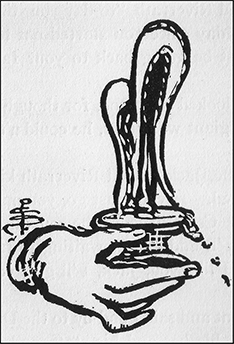
84. A Cup from A Book of Friendly Giants, illustrated by Pamela Colman Smith, 1914. (Illustration courtesy of authors, private collection.)

86. The Miraculous Medal, photograph by authors.
That the cup is being linked to Mariology (the study of the person of the Virgin Mary) is no surprise, for we have a photograph of one of the Smallhythe women at that time offering flowers to a statuette of the Virgin Mary in a small outdoor shrine upon a table alike to the one in the Magician card.
This intimation as Waite calls it is what truly lies behind the minor arcana: the mysteries of the divine feminine as the Shekinah or Mary upon the Tree of Life, leading the soul back to the Garden. Waite further teases this secret by referring to the divinatory meaning as “the house of the true heart”; this true heart being the “immaculate heart of Mary” in Catholic teaching.
From the seven sacraments of the Catholic faith, the Ace of Cups symbolises a conjunction of the Eucharist; within the Holy Communion the chalice is symbolic of the forgiveness of sin through Christ’s sacrifice, and the host borne by the dove represents confirmation of the Holy Spirit.
Together these symbols denote the Ace of Cups as washing away all that has gone before, and confirming positive grace to all that follows. In a reversed sense, this would indeed signify a “revolution.”

87. The Worship of Mary at Smallhythe Place. (Also note the flowers that appear in the 6 of Cups.) (Courtesy of the National Trust, used under license.)
–The Suit of Swords–
King

He sits in judgment, holding the unsheathed sign of his suit. He recalls, of course, the conventional Symbol of justice in the Trumps Major, and he may represent this virtue, but he is rather the power of life and death, in virtue of his office.
Divinatory meanings: Whatsoever arises out of the idea of judgment and all its connexions-power, command, authority, militant intelligence, law, offices of the crown, and so forth.
Reversed: Cruelty, perversity, barbarity, perfidy, evil intention.
Person: Judgemental.
Part of self: Inner critic.
Energy: Penetrating cuts to the truth of the matter.
Queen

Her right hand raises the weapon vertically and the hilt rests on an arm of her royal chair; the left hand is extended, the arm raised; her countenance is severe but chastened; it suggests familiarity with sorrow. It does not represent mercy, and, her sword notwithstanding, she is scarcely a symbol of power.
Divinatory meanings: Widowhood, female sadness and embarrassment, absence, sterility, mourning, privation, separation.
Reversed: Malice, bigotry, artifice, prudery, bale, deceit.
Person: Brooding person who does not suffer fools gladly.
Part of self: Cynical side.
Energy: A realist who banks on security, not dreams.
The Queen of Swords is depicted in a specific gesture that immediately and clearly connects it to the images we have of Ellen Terry playing the Viking Queen Hjördis in the play The Vikings of Helgeland, by Henrik Ibsen.
It is therefore a good sign we are on the right track with these theatrical correspondences when we also learn that Hjördis means “goddess of the sword.”
The character of Hjördis deepens our appreciation of the Queen of Swords. In the play, she is first mentioned as encouraging her husband to war with “scornful words,” hindering efforts of peace, a behaviour for which she appears to be already known. When Waite writes this is a card of “bale” when reversed, he is presenting this side of the image, as “bale” is an archaic word meaning “evil considered as a destructive force.” The words of the Queen of Swords can be baleful indeed and lead to much misery.
Other character keywords we can gather from the play include: cold, scornful, bitter, suppressed, and controlling. On a more positive note, also proud and stately. In many ways, the Queen of Swords is the opposite of the 9 of Pentacles, for as Hjördis says in Act I, “Cage an eagle and it will bite at the wires, be they of iron or of gold.”
The card image is also inspired by the Sola Busca Queen of Swords, representing Olimpia (Olympias), sister of Alexander I.

89. Ellen Terry as Hiordis in Ibsen’s The Vikings of Helgeland (1903) by Pamela Colman Smith (1878–1951). (Courtesy of the National Trust, used under license.)
The tassels adorning the wrists of the Queen are notable in that a close-up view of the original “Rose and Lilies” deck shows on the right tassel that these are rose and lily designs, similar to the rose and lilies elsewhere through the deck. The Queen of Swords wears these symbols of passion and purity, with all their associated iconography, as a rosary upon both her wrists. This detail has been lost in all subsequent copies of the deck.
A side note on butterflies: The butterflies that adorn the Queen were personally significant to Pamela; artists at the Pratt Institute where she studied were encouraged to paint real butterflies in their practice. There are extant photographs of the students (at the time Pamela was there) looking at glass jars containing butterflies.
Knight

He is riding in full course, as if scattering his enemies. In the design he is really a prototypical hero of romantic chivalry. He might almost be Galahad, whose sword is swift and sure because he is clean of heart.
Divinatory meanings: Skill, bravery, capacity, defence, address, enmity, wrath, war, destruction, opposition, resistance, ruin. There is therefore a sense in which the card signifies death, but it carries this meaning only in its proximity to other cards of fatality.
Reversed: Imprudence, incapacity, extravagance.
Person: Intrepid go-getter.
Part of self: Rebellious.
Energy: Defensive.
Page

A lithe, active figure holds a sword upright in both hands, while in the act of swift walking. He is passing over rugged land, and about his way the clouds are collocated wildly. He is alert and lithe, looking this way and that, as if an expected enemy might appear at any moment.
Divinatory meanings: Authority, overseeing, secret service, vigilance, spying, examination, and the qualities thereto belonging.
Reversed: More evil side of these qualities; what is unforeseen; unprepared state; sickness is also intimated.
Person: Quick-witted young person who always has a response ready.
Part of self: Ego.
Energy: Air of confidence.
Ten

A prostrate figure, pierced by all the swords belonging to the card.
Divinatory meanings: Whatsoever is intimated by the design; also pain, affliction, tears, sadness, desolation. It is not especially a card of violent death.
Reversed: Advantage, profit, success, favour, but none of these are permanent; also power and authority.
The secret of this card is contained in the actor’s hand gesture and clothing. Here we see another gulf between Waite’s offhand and brief description and Pamela’s design principles. The hand gesture of the corpse is that of the papal blessing we see in the Hierophant card, and subverted in the Devil card. The connection between the murdered character on this card and the Hierophant is made clearer by the white and red clothes; both wear the same, although the murdered body has a dull brown undershirt.
The murdered character is none other than the Hierophant (Pope), who in Pamela’s experience would have been Thomas Becket, immortalised by Henry Irving in Tennyson’s play of the same name. Becket was Archbishop of Canterbury from 1162 until his murder by four knights in 1170. A hairshirt was said to have been found under Becket’s outer garments, a symbol of penance—the corpse’s dull brown shirt. Similarly, in the play as allegedly in real life, the assassination scene is immediately attended by a dark storm, as seen in the card:
DE BRITO.
This last to rid thee of a world of brawls! (Kills him.)
The traitor’s dead, and will arise no more.
FITZURSE.
Nay, have we still’d him? What! the great Archbishop!
Does he breathe? No?
DE TRACY.
No, Reginald, he is dead.
(Storm bursts.) [Authors’ note: A tremendous thunderstorm actually
broke over the Cathedral as the murderers were leaving it.]
DE MORVILLE.
Will the earth gape and swallow us?
DE BRITO.
The deed’s done—
Away!
The nature of the murder was quite violent; it was noted that one of the swords had severely wounded Becket’s head, a detail captured in Pamela’s image with one sword planted firmly in the victim’s head. There would have been no specific design reason to have one sword in the head (it would have done easily as well in the body), so we propose that Pamela painted it with deliberation.
Whilst in the original story there were four knights and four swords, Pamela has here applied it to the 10 of Swords as more fitting. We have seen elsewhere Pamela shifting such numbers about; for example using the Sola Busca 6 of Coins as the 8 of Pentacles.
There’s a coincidental reference to the ten swords found in Shakespeare’s Twelfth Night:
SIR TOBY BELCH
Act III, scene II
Why, then, build me thy fortunes upon the basis of valor. Challenge me the count’s youth to fight with him. Hurt him in eleven places. My niece shall take note of it, and assure thyself, there is no love-broker in the world can more prevail in man’s commendation with woman than report of valor.
The “eleven places,” according to Professor William M. Gaugler are actually the ten places of sword-thrusts used in fencing of the time, with the additional central thrust to the opponent’s stomach.134
Nine

One seated on her couch in lamentation with the swords over her. She is as one who knows no sorrow which is like unto hers. It is a card of utter desolation.
Divinatory meanings: Death, failure, miscarriage, delay, deception, disappointment, despair.
Reversed: Imprisonment, suspicion, doubt, reasonable fear, shame.
This card signifies out-of-control thinking and obsession with your own state. It is the place where we can plunge deeper and deeper into despair. Pamela has likely used her experience with Romeo and Juliet in this scene, as Juliet is, as Waite writes (probably unknowingly) of the image Pamela has presented him, “one who knows no sorrow which is like unto hers.” It is the counterpoint to the 2 of Cups, and often represents emotional despair arising from relationship breakup.
There is a secret in this image in that the quote in the scene that already fits the image from Romeo and Juliet also contains another very specific and unique reference—one Pamela has placed in the carving underneath the bed. The card shows a carving of a man looking to be beating another man who lies prone. This scene has sometimes been suggested as the biblical myth of Cain and Abel, one of whom beat the other with a weapon lying on the ground, possibly a bone. Now read Juliet’s monologue in this scene, as she wakes in her bed and sits up distraught just before drinking the sleeping draught.
ROMEO AND JULIET
Act IV, scene III
JULIET
O, if I wake, shall I not be distraught,
Environed with all these hideous fears?
And madly play with my forefather’s joints?
And pluck the mangled Tybalt from his shroud?
And, in this rage, with some great kinsman’s bone,
As with a club, dash out my desperate brains?
O, look! methinks I see my cousin’s ghost
Seeking out Romeo, that did spit his body
Upon a rapier’s point: stay, Tybalt, stay!
Romeo, Romeo, Romeo! Here’s drink—I drink to thee.
A final correspondence to this card was linked earlier in this book to the “Wake, Dearest” flower in the Burne-Jones flower book based on its design alone—the correspondence of that flower to this scene is through the lens of symbolism.
Eight

A woman, bound and hoodwinked, with the swords of the card about her. Yet it is rather a card of temporary durance than of irretrievable bondage.
Divinatory meanings: Bad news, violent chagrin, crisis, censure, power in trammels, conflict, calumny; also sickness.
Reversed: Disquiet, difficulty, opposition, accident, treachery; what is unforeseen; fatality.
Here is a card signifying a mental situation that seems insurmountable, but it is transitory and will be overcome. We’ve all been through times when we feel there’s no way out and we cannot endure a situation any longer—and this card tells us that it will pass. The crisis will be resolved; the mental fever will not claim us.
Seven

A man in the act of carrying away five swords rapidly; the two others of the card remain stuck in the ground. A camp is close at hand.
Divinatory Meanings: Design, attempt, wish, hope, confidence; also quarrelling, a plan that may fail, annoyance. The design is uncertain in its import, because the significations are widely at variance with each other.
Reversed: Good advice, counsel, instruction, slander, babbling.
The most notable feature of this image that has been remarked upon over the last century is the main figure’s gait, who appears to be sneakily escaping with the swords. Similarly remarked upon is the fact that he is holding the swords by their blades—hardly the work of a warrior or spy. The solution to this design’s mystery is again found in a Shakespeare reference from which Pamela likely drew the card. It is from Henry V, describing exactly the scene Pamela has painted. The soldiers in silhouette are also mentioned, and the figure’s identity is an armourer whose work gives a “dreadful note of preparation.” He carries the swords not as a fighter but as a swordsmith behind the scenes of battle—adding to our interpretation of the card as a reminder to check behind the scenes.
Henry V
Act IV, prologue
Now entertain conjecture of a time
When creeping murmur and the poring dark
Fills the wide vessel of the universe.
From camp to camp, through the foul womb of night,
The hum of either army stilly sounds,
That the fixed sentinels almost receive
The secret whispers of each other’s watch.
Fire answers fire, and through their paly flames
Each battle sees the other’s umbered face.
Steed threatens steed, in high and boastful neighs
Piercing the night’s dull ear; and from the tents
The armorers, accomplishing the knights,
With busy hammers closing rivets up,
Give dreadful note of preparation.
The country cocks do crow, the clocks do toll,
And, the third hour of drowsy morning named,
Proud of their numbers and secure in soul,
The confident and overlusty French
Do the low-rated English play at dice
And chide the cripple, tardy-gaited night,
Who like a foul and ugly witch doth limp
So tediously away. The poor condemnèd English,
Like sacrifices, by their watchful fires
Sit patiently and idly ruminate
The morning’s danger; and their gesture sad,
Investing lank-lean cheeks and war-worn coats,
Presenteth them unto the gazing moon
So many horrid ghosts. Oh, now, who will behold
The royal captain of this ruined band.
The design here is also based on the 7 of Swords in the Sola Busca, Pamela capturing the leapfrogging gait of the young man across the shield. The Latin on the shield is SPQR, the abbreviation of Senatus Populusque Romanus, for “The People and the Senate of Rome.”
This is the card of planning and manipulation that may or may not work. It warns of taking actions that may result in failure at the last moment. The advice would be to slow down, wait, and think again!
Six

A ferryman carrying passengers in his punt to the further shore. The course is smooth, and seeing that the freight is light, it may be noted that the work is not beyond his strength.
Divinatory meanings: journey by water, route, way, envoy, commissionary, expedient.
Reversed: Declaration, confession, publicity; one account says that it is a proposal of love.
We were interested in the boat in the 6 of Swords; it seemed—like so many of the cards—to be such a real image capturing a specific emotion and scene. Whilst it could well be illustrating a certain story (others have suggested the Grail legends), it appeared to us to be more simply something Pamela had drawn from real life. Our first conclusion was that it was drawn from Battersea Park’s boating lake, which was literally opposite where Pamela was living in London at the time. When we discovered she had been more likely staying at Smallhythe, we put the thought to one side, as there were no boating lakes around that area, just the coast.
It was at the last minute that the universe conspired to provide an answer—this time from history and our decision to always go back to 1909, and stay in that time. In the midst of an otherwise fruitless search through Ellen Terry’s personal photographs and keepsakes, we discovered a postcard. The postcard was from Smallhythe at the time, and shows clearly that although it is no longer present, there was a boat and small pond at the property. We believe it is from this Pamela drew the 6 of Swords; as ever, there was no need to travel beyond the garden.
Compare this to the scene shown on the 4 of Wands that shows the terrace at Smallhythe Place, of which we found a photograph next to this one of the boat, and you will get a strange sense of familiarity; the cards are indeed images of this singular time and place in history.
This card signifies taking stock of a situation, thinking it through, leaving unnecessary baggage behind, and moving on when the time is right. All will be well if you choose the right conditions. A way for you to go forward will open, but you may need to take advice from somebody in the know.

94. Ellen Terry’s Cottage, c. 1909. (Courtesy of the Victoria and Albert Museum, London, used under license.)
Five

A disdainful man looks after two retreating and dejected figures. Their swords lie upon the ground. He carries two others on his left shoulder, and a third sword is in his right hand, point to earth. He is the master in possession of the field.
Divinatory meanings: Degradation, destruction, revocation, infamy, dishonour, loss, with the variants and analogues of these.
Reversed: The same; burial and obsequies.
These three figures have often been the subject of discussion, for they seem in a very definite but unstated relationship. Waite’s description does not add to any interpretation other than to suggest the figure holding the swords is the one in control. In one of Pamela’s earlier works, we perhaps can see these three figures, for they are the three pirates who live by the coast: Dare-and-Do, Catch-and-Kill, and Fear-and-Fly.
Dare-and-Do is at the coastline, suffering the results of his recklessness, whilst Fear-and-Fly is gathering up the swords. Catch-and-Kill is always between the two, trying to curb the hastiness of the former and encourage the anxious cautiousness of the latter.
These characters can add to a reading in giving three aspects of a situation we must master to avoid the misfortune implied in the card. When we are too cautious, too hasty, or too quick to try to serve others, we may meet misfortune. In the story illustrated by this piece, the three pirates end up as lowly servants for giants after a long tale of over-ambitious schemes.

95. Dare-and-Do, Catch-and-Kill, and Fear-and-Fly from A Book of Friendly Giants, illustrated by Pamela Colman Smith, 1914. (Illustration courtesy of authors, private collection.)
Four

The effigy of a knight in the attitude of prayer, at full length upon his tomb.
Divinatory meanings: Vigilance, retreat, solitude, hermit’s repose, exile, tomb and coffin. It is these last that have suggested the design.
Reversed: Wise administration, circumspection, economy, avarice, precaution, testament.
This card signifies a period of retreat, especially after conflict. It is the best action to take, it is a waiting time, but be alert until it is safe to return to the fray. Waite says of this card “vigilance” and “retreat.”
Waite would have associated the “pax” in the stained glass window with the Rosicrucian salutation, Deus nobiscum, Pax profunda, “Peace profound, my Brethren: Immanuel, God is with us.” It is “like the dead and forgotten Boulanger testifying from the tomb of his Deism.”135
Pamela has taken inspiration from the tomb in Winchelsea Church, where the word “peace” (pax) is seen in the stained glass near the tomb—by the Mary/High Priestess figure.
Three

Three swords piercing a heart; cloud and rain behind.
Divinatory meanings: Removal, absence, delay, division, rupture, dispersion, and all that the design signifies naturally, being too simple and obvious to call for specific enumeration.
Reversed: Mental alienation, error, loss, distraction, disorder, confusion.
This card signifies unrest and rebellion. This is a card that does not speak well of happy relations! A relationship split could occur and it will be brutal. It can signify a situation in a relationship that is difficult for a person to extricate themselves from easily; it the proverbial fix! A messy divorce with a third person involved could result.
Two

A hoodwinked female figure balances two swords upon her shoulders.
Divinatory meanings: Conformity and the equipoise which it suggests, courage, friendship, concord in a state of arms; another reading gives tenderness, affection, intimacy. The suggestion of harmony and other favourable readings must be considered in a qualified manner, as Swords generally are not symbolical of beneficent forces in human affairs.
Reversed: Imposture, falsehood, duplicity, disloyalty.
As with the 3 of Swords, this card is one of being in a fix of one’s own making. This can be a situation where one is forced to conform to the will of another. This is a situation that cannot persist, for it will eventually be too much to bear. Waite says of this card and the suit of swords that they “are not usually symbolic of beneficent forces in human affairs.”
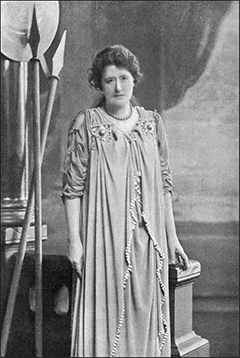
98. Ellen Terry as Cordelia in King Lear, from Shakespeare’s Complete Works, intro. H. G. Bell (1899). (Photograph courtesy of authors, private collection.)
Ace

A hand issues from a cloud, grasping a sword, the point of which is encircled by a crown.
Divinatory meanings: Triumph, the excessive degree in everything, conquest, triumph of force. It is a card of great force, in love as well as in hatred. The crown may carry a much higher significance than comes usually within the sphere of fortune-telling.
Reversed: The same, but the results are disastrous; another account says conception, childbirth, augmentation, multiplicity.
When looking at this sword and the original Golden Dawn description, we see that Waite and Smith are drawing on a magical ritual heritage in their Aces. The Golden Dawn describes this particular ace as “a white radiating Angelic Hand, issuing from clouds, and grasping the hilt of a Sword, which supports a white radiant celestial Crown from which depend, on the right, the olive branch of Peace, and on the left, the Palm branch of suffering. Six Vaus fall from its point.”136 This is developed from an illustration and text description by Éliphas Lévi, in presenting the formation and consecration of a magical sword in a chapter on the Chariot card in his Magical Ritual of the Sanctum Regnum (published in 1896 but written by Lévi at an unknown earlier date). Lévi illustrates it with a hand issuing from a cloud grasping a sword.137
Pamela has depicted the sword exactly as the Golden Dawn description, showing she had access to those descriptions in Book T. As we suspect, Waite passed on a scant version of Book T, which would have contained these descriptions as well as the main keywords for the minors. Perhaps after creating the Aces in a straightforward copy of the Golden Dawn descriptions, they decided the other minor cards should follow a “scenic” illustration model.
Actually, Pamela has painted Yod characters rather than Vau characters on her Ace. This mutation of the original Golden Dawn descriptions seems haphazard; in the Ace of Cups, she replaces the Heh of the “Supernal Mother” described in Book T with the reversed “M” of Mary; in the Ace of Wands, the twenty-two “leaping flames or Yods” become eight falling leaves; and in the Ace of Pentacles, there are no “twelve rays” as described in Book T. It is the Ace of Wands (kabbalistically the first in the sequence of the cards) that bears the closest relationship to any Golden Dawn description, followed by the Ace of Swords—the second in sequence. We wonder if Pamela started the first card and perhaps the next two as part of what was originally intended as a straight version of the Golden Dawn Tarot.
Whatever the secrets behind the design choice, the Ace of Swords shows the two-edged nature of invoked force compared to the natural force of the Ace of Wands. Lévi said that the Magus (the Charioteer as Hermes) had to learn to wield both the Swords and the wands; strength and wisdom. The sword can be most difficult; upright, it signifies a divine end—the crown of Kether on the Tree of Life; reversed, it is blind aggression, dominance, and power for their own sakes, devoid of reason.
Reading tip: If the Ace of Swords appears in a spread, look at the card(s) to which it points. These may reveal the querent’s secret motivation with regard to the situation. If it points to many cards (e.g. at the bottom of a Celtic Cross), then the querent is confused and has many ambitions or desires. If it is reversed and at the bottom of a spread or not pointing to any other card, look above it to see what unconscious motivation is driving the situation, possibly to the querent’s ruin if it is not recognised.
Conclusion
Waite, whilst dismissive of the minor cards as mere fortune-telling, recognised the value of Pamela’s design and artistry in producing the scenes and characters that populated the cards. This elevated the pip cards to new possibilities beyond their original design as cartomantic tools. Waite wrote:
When the pictures in the present case go beyond the conventional meanings they should be taken as hints of possible developments along the same lines; and this is one of the reasons why the pictorial devices here attached to the four denaries will prove a great help to intuition. The mere numerical powers and bare words of the meanings are insufficient by themselves; but the pictures are like doors which open into unexpected chambers, or like a turn in the open road with a wide prospect beyond.138
